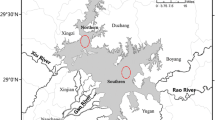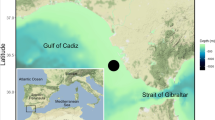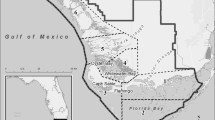Abstract
There is a great need to understand how resource interactions alter the functioning of ecosystems, where the selective elimination of pelagic fishes can lead to changes in food web structure. This work analyzes the trophic niches of three species of commercial importance in the Galapagos Marine Reserve, yellowfin tuna, Thunnus albacares (TA), skipjack tuna, Katsuwonus pelamis (KP), and wahoo, Acanthocybium solandri (AS), via multiple analyses. According to the prey-specific index of relative importance, the most important prey for TA was Dosidicus gigas, while for AS it was unidentified pelagic fish. Interspecific differences were found between the isotopic signatures of AS and those of TA and KP. The isotope mixing model provides evidence for some predominance of D. gigas in the diets of TA and KP, while the fishes Selar crumenophthalmus and Paranthias colonus contribute to the diet of AS. The stable isotope Bayesian ellipses show a high overlap between TA and KP, suggesting a similar use of resources and feeding areas, while the ellipse of AS does not overlap with that of the other species. Both AS and TA were present around the islands more commonly during the day, with a peak in detections in the morning for AS and a greater presence of TA throughout the afternoon; there were only a few detections of KP in the days immediately after tagging. In summary, the results of this study suggest a pelagic foraging strategy with differential consumption of prey between AS and the other species.






Similar content being viewed by others
References
Alatorre-Ramirez V, Galván-Magaña F, Torres-Rojas Y, Olson R (2017) Trophic segregation of mixed schools of yellowfin tuna (Thunnus albacares) and skipjack tuna (Katsuwonus pelamis) caught in the eastern tropical Pacific Ocean. Fish Bull 115:252–268
Allen G, Robertson D (1994) Fishes of the tropical eastern Pacific. University of Hawaii Press, Honolulu
Alverson F (1963) The food of yellowfin and skipjack tunas in the eastern tropical Pacific Ocean. Inter-American Tropical Tuna Communications Bulletin 7:295–396
Amundsen P, Gabler H, Staldvik F (1996) A new approach to graphical analysis of feeding strategy from stomach contents data-modification of the Costello (1990) method. J Fish Biol 48:607–614
Arai T, Kotake A, Kayama S, Ogura M, Watanabe Y (2005) Movements and life history patterns of the skipjack tuna Katsuwonus pelamis in the western Pacific, as revealed by otolith Sr/Ca ratios. J Mar Biol Assoc UK 85:1211–1216
Au D (1991) Polyspecific nature of tuna schools: sharks, dolphin, and seabird associates. Fish Bull 89:343–354
Baque-Menoscal J, Páez-Rosas D, Wolff M (2012) Hábitos alimentarios de dos peces pelágicos Thunnus albacares y Acanthocybium solandri de la Reserva Marina de Galápagos. Rev Biol Mar Oceanog 47:1–11
Batschelet E (1981) Circular statistics in biology. Academic Press, London
Batts B (1972) Age and growth of skipjack tuna, Katsuwonus pelamis (Linnaeus), in North Carolina waters. Chesapeake Science 13:237–244
Bearhop S, Adams C, Waldron S, Fuller R, Macleod H (2004) Determining trophic niche width: a novel approach using stable isotope analysis. J Anim Ecol 73:1007–1012
Bernal D, Sepúlveda C, Musyl M, Brill R (2009) The eco-physiology of swimming and movement patterns of tunas, billfishes, and large pelagic sharks. In Fish locomotion-an etho-ecological perspective. Enfield: Science Publishers.
Block B, Keen K, Castillo B, Dewar H, Freund E, Marcinek D, Brill R, Farwell C (1997) Environmental preferences of yellowfin tuna (Thunnus albacares) at the northern extent of its range. Mar Biol 130:119–132
Boecklen W, Yarnes C, Cook B, James A (2011) On the use of stable isotopes in trophic ecology. Annu Rev Ecol Evol Syst 42:411–440
Bolnick D, Svanback J, Fordyce L, Yang J, Davis C, Husley D, Forister M (2003) The ecology of individuals: incidence and implications of individual specialization. Am Nat 161:1–28
Brill R, Block B, Boggs C, Bigelow K, Freund E, Marcinek D (1999) Horizontal movements and depth distribution of large adult yellowfin tuna (Thunnus albacares) near the Hawaiian Islands, recorded using ultrasonic telemetry: implications for the physiological ecology of pelagic fishes. Mar Biol 133:395–408
Brown S, Bizzarro J, Cailliet G, Ebert D (2012) Breaking with tradition: redefining measures for diet description with a case study of the Aleutian skate Bathyraja aleutica (Gilbert 1896). Environ Biol Fish 95:3–20
Bucaram S, Hearn A, Trujillo A, Rentería W, Bustamante R, Morán G, Reck G, García J (2018) Assessing fishing effects inside and outside an MPA: The impact of the Galapagos Marine Reserve on the Industrial pelagic tuna fisheries during the first decade of operation. Mar Policy 87:212–225
Castrejon M, Charles A (2013) Improving fisheries co-management through ecosystem-based spatial management: The Galapagos Marine Reserve. Mar Policy 38:235–245
Caut S, Angulo E, Courchamp F (2009) Variation in discrimination factors (δ15N and δ13C): the effect of diet isotopic values and applications for diet reconstruction. J Appl Ecol 46:443–453
Chen H, Hagerty S, Crotty S, Bertness M (2016) Direct and indirect trophic effects of predator depletion on basal trophic levels. Ecology 97:338–346
Clarke M (1986) A Handbook for the Identification of Cephalopod Beaks. Clarendon Press, Oxford
Clarke K, Warwick R (2001) Change in marine communities: an approach to statistical analysis and interpretation, Primer-E Ltd, Plymouth.
Dalgleish H, Koons D, Adler P (2010) Can life-history traits predict the response of forb populations to changes in climate variability? J Ecol 98:209–217
Doney S, Ruckelshaus M, Duffy J, Barry J, Chan F, English C, Galindo H, Grebmeier J, Hollowed A, Knowlton N, Polovina J, Rabalais N, Sydeman W, Talley L (2012) Climate change impacts on marine ecosystems. Annu Rev Mar Sci 4:11–37
Duffy L, Olson R, Lennert-Cody C, Galván-Magaña F, Bocanegra N, Kuhnert P (2015) Foraging ecology of silky shark Carcharhinus falciformis, captured by the tuna purseseine fishery in the eastern Pacific Ocean. Mar Biol 162:571–593
Ehrhardt N, Solís N, Jaquemin P, Ortiz C, Ulloa R, González D, García B (1986) Análisis de la biología y condiciones del stock del calamar gigante Dosidicus gigas en el Golfo de California, México, durante 1980. Cienc Pesq 5:63–76
Eslava N, González L, Gaertner D (2003) Asociación de la abundancia y la distribución vertical de atunes y peces de pico en el sureste del Mar Caribe. Rev Biol Trop 51:213–219
Fischer W, Krupp F, Schneider W, Sommer C, Carpenter K, Niem V (1995) Guía FAO para la identificación de especies para los fines de la pesca. In Pacífico centro-oriental. Vol. I. Plantas e invertebrados. Rome: FAO press.
Fitch J, Brownell R Jr (1968) Fish otholits in cetacean stomach and their importance in interpreting feeding habits. J Fish Res Board Can 25:2561–2574
France R (1995) Carbon-13 enrichment in benthic compared to planktonic algae: foodweb implications. Mar Ecol Prog Ser 124:307–312
Galván-Magaña F (1988) Composición y análisis de la dieta del atún aleta amarilla Thunnus albacares en el Océano Pacif́ ico mexicano durante el periodo 1984–1985. M.S. thesis, 86 p. Centro Interdisciplinario de Ciencias Marinas del Instituto Politécnico Nacional, La Paz, Baja California Sur, México
Galván-Magaña F, Polo-Silva C, Hernández-Aguilar S, Sandoval-Londoño A, Ochoa-Díaz R, Aguilar-Castro N, Castañeda-Suárez D, Chavez-Costa A, Baigorrí-Santacruz A, Torres-Rojas Y, Abitia-Cárdenas L (2013) Shark predation on cephalopods in the Mexican and Ecuadorian Pacific Ocean. Deep-Sea Res II Top Stud Oceanogr 95:52–62
García-Godos I (2001) Patrones morfológicos del otolito sagitta de algunos peces óseos del mar peruano. Instituto del Mar del Perú Press, Lima
Gislason H, Daan N, Rice J, Pope J (2010) Size, growth, temperature and the natural mortality of marine fish. Fish Fish 11:149–158
Goericke R, Fry B (1994) Variations of marine plankton δ13C with latitude, temperature, and dissolved CO2 in the world ocean. Global Biogeochem Cy 8:85–90
Graham B, Grubbs D, Holland K, Popp B (2007) A rapid ontogenetic shift in the diet of juvenile yellowfin tuna from Hawaii. Mar Biol 150:647–658
Grove J, Lavenberg R (1997) The fishes of the Galapagos Islands. Stanford University Press, California
Hampton J, Sibert J, Kleiber P, Maunder M, Harley S (2005) Decline of Pacific tuna populations exaggerated? Nature 434:E1–E2
Hastings P, Findley L, Van der Heiden A (2010) Fishes of the Gulf of California. Arizona University Press, Tucson
Hearn A (2008) The rocky path to sustainable fisheries and conservation in the Galapagos Marine Reserve. Ocean Coast Manage 51:567–574
Hearn A, Ketchum J, Klimley A, Espinoza E, Peñaherrera C (2010) Hotspots within hotspots? Hammerhead shark movements around Wolf Island, Galapagos Marine Reserve. Mar Biol 157:1899–1915
Hunsicker M, Olson R, Essington T, Maunder M, Duffy L, Kitchell J (2012) Potential for top-down control on tropical tunas based on size structure of predator–prey interactions. Mar Ecol Prog Ser 445:263–277
Hussey N, Brush J, McCarthy I, Fisk A (2010) δ15N and δ13C diet–tissue discrimination factors for large sharks under semi-controlled conditions. Comp Biochem Physiol A Mol Integr Physiol 155:445–453
Hyslop E (1980) Stomach contents analysis: a review of methods and their application. J Fish Biol 17:411–429
Itano D, Holland K (2000) Movement and vulnerability of bigeye (Thunnus obesus) and yellowfin tuna (Thunnus albacares) in relation to FADs and natural aggregation points. Aquat Living Resour 13:213–223
Iversen E, Yoshida H (1957) Notes on the biology of the wahoo in the Line Islands. Pac Sci 11:370–379
Jackson A, Inger R, Parnell A, Bearhop S (2011) Comparing isotopic niche widths among and within communities: SIBER—Stable Isotope Bayesian Ellipses. J Animal Ecol 80:595–602
Ketchum J, Hearn A, Klimley A, Peñaherrera C, Espinoza E, Bessudo S, Soler G, Arauz R (2014) Inter-island movements of scalloped hammerhead sharks (Sphyrna lewini) and seasonal connectivity in a marine protected area of the eastern tropical Pacific. Mar Biol 161:939–951
Kim S, Martínez del Rio C, Casper D, Koch P (2012) Isotopic incorporation rates for shark tissues from a long-term captive feeding study. J Exp Biol 215:2495–2500
Korsmeyer K, Dewar H (2001) Tuna metabolism and energetics. In: Block B, Stevens G (eds) Fish physiology: tuna physiology, ecology, and evolution. Academic Press, San Diego
Layman C, Arrington D, Montaña C, Post D (2007) Can stable isotope ratios provide for community-wide measures of trophic structure? Ecology 88:42–48
Logan J, Jardine T, Miller TJ, Bunn S, Cunjak R, Lutcavage M (2008) Lipid corrections in carbon and nitrogen stable isotope analyses: comparison of chemical extraction and modelling methods. J Anim Ecol 77:838–846
Marasco R, Goodman D, Grimes C, Lawson P, Punt A, Quinn T (2007) Ecosystem-based fisheries management: some practical suggestions. Can J Fish Aquat Sci 64:928–939
Martínez del Rio C, Wolf N, Carleton S, Gannes L (2009) Isotopic ecology ten years after a call for more laboratory experiments. Biol Rev 84:91–111
Matich P, Heithaus M, Layman C (2011) Contrasting patterns of individual specialization and trophic coupling in two marine apex predators. J Anim Ecol 80:294–305
McConnaughey T, McRoy C (1979) Food-web structure and fractionation of carbon isotopes in the Bering Sea. Mar Biol 53:257–262
Mendoza-Ávila M, Zavala-Zambrano G, Galván-Magaña F, Loor-Andrade P (2017) Feeding habits of wahoo (Acanthocybium solandri) in the eastern Pacific Ocean. J Mar Biol Assoc UK 97:1505–1510
Nakamura E (1965) Food and feeding habits of skipjack tuna (Katsuwonus pelamis) from the Marquesas and Tuamotu Islands. Trans Am Fish Soc 94:236–242
Newsome S, Martinez del Rio C, Bearhop S, Phillips D (2007) A niche for isotopic ecology. Front Ecol Environ 5:429–436
Nielsen J, Clare E, Hayden B, Brett M, Kratina P (2018) Diet tracing in ecology: Method comparison and selection. Methods Ecol Evol 9:278–291
Nigmatullin C, Nesis K, Arkhipkin A (2001) A review of the biology of the jumbo squid Dosidicus gigas (Cephalopoda: Ommastrephidae). Fish Res 54:9–19
Nikolsky G (1963) The ecology of fishes. Academic Press, London
Olson R, Boggs C (1986) Apex predation by yellowfin tuna (Thunnus albacares): independent estimates from gastric evacuation and stomach contents, bioenergetics, and cesium concentrations. Can J Fish Aquat Sci 43:1760–1775
Olson R, Duffy L, Kuhnert P, Galván-Magaña F, Bocanegra-Castillo N, Alatorre-Ramírez V (2014) Decadal diet shift in yellowfin tuna (Thunnus albacares) suggests broad-scale food web changes in the eastern tropical Pacific Ocean. Mar Ecol Prog Ser 497:157–178
Olson R, Young J, Ménard F, Potier M, Allain V, Goñi N, Logan J, Galván-Magaña F (2016) Bioenergetics, trophic ecology, and niche separation of tunas. Adv Mar Biol 74:199–344
Oxenford H, Murray P, Luckhurst B (2003) The biology of guajo (Acanthocybium solandri) in the western central Atlantic. Gulf Caribb Res 15:33–49
Oyafuso Z, Toonen R, Franklin E (2016) Temporal and spatial trends in prey composition of wahoo Acanthocybium solandri: a diet analysis from the central North Pacific Ocean using visual and DNA bar-coding techniques. J Fish Biol 88:1501–1523
Páez-Rosas D, Aurioles-Gamboa D, Alava J, Palacios D (2012) Stable isotopes indicate differing foraging strategies in two sympatric otariids of the Galapagos Islands. J Exp Mar Biol Ecol 425:44–52
Páez-Rosas D, Insuasti-Zarate P, Riofrío-Lazo R, Galván-Magaña F (2018) Feeding behavior and trophic interaction of three shark species in the Galapagos Marine Reserve. PeerJ. https://doi.org/10.7717/peerj.4818
Palacios D, Bograd S, Foley, D, Schwing (2006) Oceanographic characteristics of biological hot spots in the North Pacific: a remote sensing perspective. Deep-Sea Res II Top Stud Oceanogr 53: 250-269.
Pancost R, Freeman K, Wakeham S, Robertson C (1997) Controls on carbon isotope fractionation by diatoms in the Peru upwelling region. Geochim Cosmochim Acta 61:4983–4991
Parnell A, Inger R, Bearhop S, Jackson A (2010) Source Partitioning Using Stable Isotopes: Coping with Too Much Variation. PLoS One. https://doi.org/10.1371/journal.pone.0009672.
Phillips D, Inger R, Bearhop S, Jackson A, Moore J, Parnell A et al (2014) Best practices for use of stable isotope mixing models in food-web studies. Can J Zool 92:823–835
Post D, Layman C, Arrington D, Takimoto G, Quattrochi J, Montaña C (2007) Getting to the fat of the matter: models, methods and assumptions for dealing with lipids in stable isotope analyses. Oecologia 152:179–189
Rosas-Luis R, Loor-Andrade P, Carrera-Fernández M, Pincay-Espinoza J, Vinces-Ortega C, Chompoy-Salazar L (2016) Cephalopod species in the diet of large pelagic fish (sharks and billfishes) in Ecuadorian waters. Fish Res 173:159–168
Ruiz-Cooley R, Villa E, Gould W (2010) Ontogenetic variation of δ13C and δ15N recorded in the gladius of the jumbo squid Dosidicus gigas: geographic differences. Mar Ecol Prog Ser 399:187–198
Schaefer K (1998) Reproductive biology of yellowfin tuna (Thunnus albacares) in the eastern Pacific tuna. Inter-American Tropical Tuna Communications Bulletin 21:205–272
Schaefer K, Fuller D (2007) Vertical movement patterns of skipjack tuna (Katsuwonus pelamis) in the eastern equatorial Pacific Ocean, as revealed with archival tags. Fish Bull 105:379–389
Schaeffer B, Morrison J, Kamykowski D, Feldman G, Xie L, Liu Y, McCulloch A, Banks S (2008) Phytoplankton biomass distribution and identification of productive habitats within the Galapagos Marine Reserve by MODIS, a surface acquisition system, and in-situ measurements. Remote Sens Environ 112:3044–3054
Scott M, Chivers S, Olson R, Fiedler P, Holland K (2012) Pelagic predator associations: tuna and dolphins in the eastern tropical Pacific Ocean. Mar Ecol Prog Ser 458:283–302
Sepulveda C, Aalbers S, Ortega-Garcia S, Wegner N, Bernal D (2011) Depth, distribution and temperature preferences of wahoo (Acanthocybium solandri) of Baja California Sur, Mexico. Mar Biol 158:917–926
Sibert J, Hampton J (2003) Mobility of tropical tunas and the implications for fisheries management. Mar Policy 27:87–95
Sibert J, Hampton J, Kleiber P, Maunder M (2006) Biomass, size, and trophic status of top predators in the Pacific Ocean. Science 314:1773–1776
Theisen T, Bowen B, Lanier W, Baldwin J (2008) High connectivity on a global scale in the pelagic wahoo, Acanthocybium solandri (tuna family Scombridae). Mol Ecol 17:4233–4247
Tieszen L, Boutton T, Tesdahl K, Slade N (1983) Fractionation and turnover of stable carbon isotopes in animal tissues: implications for d13C analysis of diet. Oecologia 57:32–37
Varela J, Larrañaga A, Medina A (2011) Prey-muscle carbon and nitrogen stable-isotope discrimination factors in Atlantic bluefin tuna (Thunnus thynnus). J Exp Mar Biol Ecol 406:21–28
Varela J, Intriago K, Flores J, Lucas-Pilozo C (2017) Feeding habits of juvenile yellowfin tuna (Thunnus albacares) in Ecuadorian waters assessed from stomach content and stable isotope analysis. Fishs Res 194:89–98
Vaudo J, Heithaus M (2011) Dietary niche overlap in a nearshore elasmobranch mesopredator community. Mar Ecol Prog Ser 425:247–260
Watanabe H (1958) On the difference of the stomach contents of the yellowfin and bigeye tunas from the western equatorial Pacific. Rep Nankai Reg Fish Res Lab 7:72–81
Acknowledgments
We thank the Galápagos National Park (GNP) for logistical support and granting us permission to collect the samples used in this study. We also thank the Universidad San Francisco de Quito (USFQ) in Ecuador and Centro Interdisciplinario de Ciencias Marinas (CICIMAR) in Mexico for financial and logistical support during the preparation of this manuscript. We thank artisanal fishermen of Galapagos, especially Carlos Bailón and his work group, who collaborated during the field phase of this project. Thanks also to the crew of the M/V Ocearch, who funded and carried out the sample collection and tagging under permit PC-01-14. J.B.-M. thanks the Charles Darwin Foundation and WWF International for the support provided for the sampling. F.G.-M. and A.T.-Q. thank the Instituto Politécnico Nacional for the fellowships granted through the "Comisión de Operación y Fomento de Actividades Académicas" (COFAA) and the "Estímulo al Desempeño de los Investigadores" (EDI). Finally, D.P.-R. and A.H. thank the Galapagos Science Center for providing the facilities for information processing and analysis.
Author information
Authors and Affiliations
Corresponding author
Additional information
Publisher’s note
Springer Nature remains neutral with regard to jurisdictional claims in published maps and institutional affiliations.
Electronic supplementary material
Annex 1
Cumulative trophic diversity curves for all stomachs of T. albacares and A. solandri. Cumulative prey diversity is based on the Shannon-Wiener index (H´) (n = optimum sample size for each species)(PNG 1813 kb)
Rights and permissions
About this article
Cite this article
Páez-Rosas, D., Galván-Magaña, F., Baque-Menoscal, J. et al. Trophic preferences of three pelagic fish inhabiting the Galapagos Marine Reserve: ecological inferences using multiple analyses. Environ Biol Fish 103, 647–665 (2020). https://doi.org/10.1007/s10641-020-00967-8
Received:
Accepted:
Published:
Issue Date:
DOI: https://doi.org/10.1007/s10641-020-00967-8




